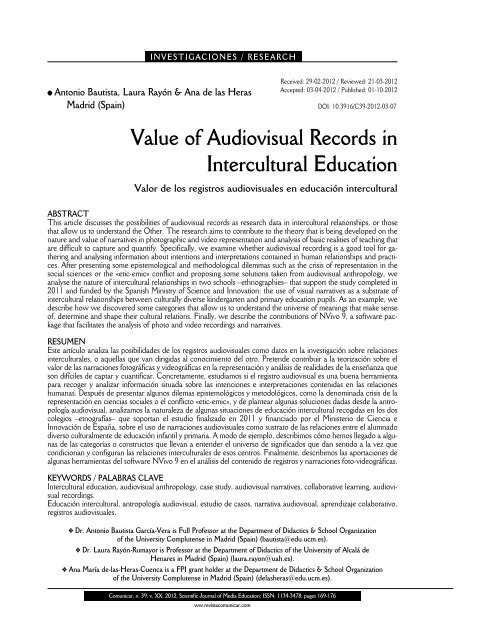Comunicar 39-ingles - Revista Comunicar
Comunicar 39-ingles - Revista Comunicar
Comunicar 39-ingles - Revista Comunicar
Create successful ePaper yourself
Turn your PDF publications into a flip-book with our unique Google optimized e-Paper software.
INVESTIGACIONES / RESEARCHl Antonio Bautista, Laura Rayón & Ana de las HerasMadrid (Spain)Received: 29-02-2012 / Reviewed: 21-03-2012Accepted: 03-04-2012 / Published: 01-10-2012DOI: 10.<strong>39</strong>16/C<strong>39</strong>-2012-03-07Value of Audiovisual Records inIntercultural EducationValor de los registros audiovisuales en educación interculturalABSTRACTThis article discusses the possibilities of audiovisual records as research data in intercultural relationships, or thosethat allow us to understand the Other. The research aims to contribute to the theory that is being developed on thenature and value of narratives in photographic and video representation and analysis of basic realities of teaching thatare difficult to capture and quantify. Specifically, we examine whether audiovisual recording is a good tool for ga -thering and analysing information about intentions and interpretations contained in human relationships and practices.After presenting some epistemological and methodological dilemmas such as the crisis of representation in thesocial sciences or the «etic-emic» conflict and proposing some solutions taken from audiovisual anthropology, weanalyse the nature of intercultural relationships in two schools –ethnographies– that support the study completed in2011 and funded by the Spanish Ministry of Science and Innovation: the use of visual narratives as a substrate ofintercultural relationships between culturally diverse kindergarten and primary education pupils. As an example, wedescribe how we discovered some categories that allow us to understand the universe of meanings that make senseof, determine and shape their cultural relations. Finally, we describe the contributions of NVivo 9, a software packagethat facilitates the analysis of photo and video recordings and narratives.RESUMENEste artículo analiza las posibilidades de los registros audiovisuales como datos en la investigación sobre relacionesinterculturales, o aquellas que van dirigidas al conocimiento del otro. Pretende contribuir a la teorización sobre elvalor de las narraciones fotográficas y videográficas en la representación y análisis de realidades de la enseñanza queson difíciles de captar y cuantificar. Concretamente, estudiamos si el registro audiovisual es una buena herramientapara recoger y analizar información situada sobre las intenciones e interpretaciones contenidas en las relacioneshumanas. Después de presentar algunos dilemas epistemológicos y metodológicos, como la denominada crisis de larepresentación en ciencias sociales o el conflicto «etic-emic», y de plantear algunas soluciones dadas desde la antropologíaaudiovisual, analizamos la naturaleza de algunas situaciones de educación intercultural recogidas en los doscolegios –etnografías– que soportan el estudio finalizado en 2011 y financiado por el Ministerio de Ciencia eInnovación de España, sobre el uso de narraciones audiovisuales como sustrato de las relaciones entre el alumnadodiverso culturalmente de educación infantil y primaria. A modo de ejemplo, describimos cómo hemos llegado a algunasde las categorías o constructos que llevan a entender el universo de significados que dan sentido a la vez quecondicionan y configuran las relaciones interculturales de esos centros. Finalmente, describimos las aportaciones dealgunas herramientas del software NVivo 9 en el análisis del contenido de registros y narraciones foto-videográficas.KEYWORDS / PALABRAS CLAVEIntercultural education, audiovisual anthropology, case study, audiovisual narratives, collaborative learning, audiovisualrecordings.Educación intercultural, antropología audiovisual, estudio de casos, narrativa audiovisual, aprendizaje colaborativo,registros audiovisuales.v Dr. Antonio Bautista García-Vera is Full Professor at the Department of Didactics & School Organizationof the University Complutense in Madrid (Spain) (bautista@edu.ucm.es).v Dr. Laura Rayón-Rumayor is Professor at the Department of Didactics of the University of Alcalá deHenares in Madrid (Spain) (laura.rayon@uah.es).v Ana María de-las-Heras-Cuenca is a FPI grant holder at the Department de Didactics & School Organizationof the University Complutense in Madrid (Spain) (delasheras@edu.ucm.es).<strong>Comunicar</strong>, n. <strong>39</strong>, v. XX, 2012, Scientific Journal of Media Education; ISSN: 1134-3478; pages 169-176ww.revistacomunicar.com
















